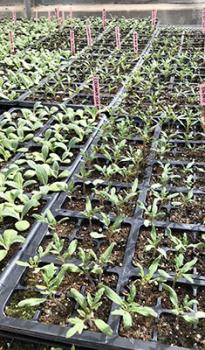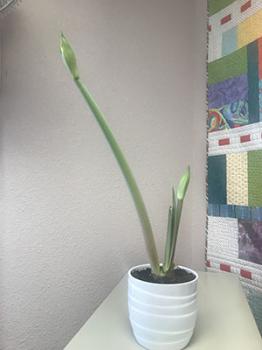February 8, 2020
Re-Prints: Tomato Plants & Amaryllis Flowers
Re-Print from February 23, 1997 - Skinny Tomato Plants Started Indoors by Dr. Curtis Smith (Photos by Dr. Marisa Thompson)
Question:
I started some tomato plants inside this winter so I could move them into the garden as soon as the weather allowed. I started them on top of the refrigerator like the books said, but they are skinny and keep falling over. They don't look as good as the plants I bought last year. What is wrong?
Answer:
The books recommend starting the seedlings on top of a refrigerator because in days when we didn't keep our homes too warm, the top of the refrigerator was warm. Many plants germinate from seed more quickly if the room in which they are kept is cool but the soil is warm. The refrigerator kept the soil warmer. Once the seeds have germinated and the new plants can be seen, they should be moved into a room with plenty of light for several hours each day.
Our windows usually don't allow enough hours of bright light and produce plants that are leggy and easily fall over. Keep the plants as close to the window as possible to maximize the light they receive. Sheer curtains can help prevent leaf burn. Don't suddenly move the plants into direct sunlight because this will burn them. Gradually increase the light to which they are exposed. If it is possible to place them outside on a brightly lighted porch during the day, this will also help, but again don't suddenly expose them to too much light. Be sure to bring them in at night. Nighttime temperatures below 50°F are not good for the seedlings; freezing temperatures are especially dangerous.
It is also wise to keep the room as cool as possible, letting the nighttime temperatures drop to about 55°F and trying to keep the daytime temperatures to about 80°F. Lower temperatures will help keep the plants stocky but cannot completely overcome insufficient light.
Another measure to take is to be sure that you do not over-fertilize the plants. When plants do not receive enough light, too much nitrogen fertilizer will cause excessive and weak growth. Once the plants are outside receiving over five hours of direct sunlight, fertilization can be increased.
Fortunately, tomato plants can be planted deeply if they become too leggy. Tomatoes will form roots along the stem if it is covered by moist soil. So, try to increase the light the plants receive, reduce the temperatures somewhat, and be sure not to provide too much nitrogen fertilizer.

Re-Print from February 11, 2000 - Amaryllis Flowers Too Tall by Dr. Curtis Smith (Photos by Dr. Marisa Thompson)
Question:
Why do our amaryllis stems always get extremely tall before the blossoms open? If we don't provide extra support, they will topple over. We generally keep the temperature of the house below 60°F.
Answer:
It is natural for amaryllis flower scapes (long, leafless stalks) to become rather tall, but they should be capable of supporting the flowers without falling over. However, in a pot with a small bottom it becomes unstable and is prone to toppling over. Don't transplant it now, but you can place it into a larger-diameter pot or decorative container. Place some gravel or rocks in the bottom of the pot to increase the container’s weight. Be careful that no water collects around the base of the pot containing the bulb as you water the plant.
Under indoor conditions, light may be limiting. Low light levels will increase the height of the flower scapes. You are doing the right thing to keep the temperatures cool in the room where the plant is growing since this helps reduce the excess height of the flower scape. While it is flowering and the leaves are absent or dormant, fertilizing is not important. Too much nitrogen fertilizer may also cause excessive flower scape growth. If you fertilize before and during flowering, use a flowering houseplant fertilizer that is low in nitrogen and higher in phosphorus. Nevertheless, the amaryllis is genetically programmed to produce tall flower scapes.

Marisa Y. Thompson, PhD, is the Extension Horticulture Specialist, in the Department of Extension Plant Sciences at the New Mexico State University Los Lunas Agricultural Science Center, email: desertblooms@nmsu.edu, office: 505-865-7340, ext. 113.
Links:
For more gardening information, visit the NMSU Extension Horticulture page at Desert Blooms and the NMSU Horticulture Publications page.
Send gardening questions to Southwest Yard and Garden - Attn: Dr. Marisa Thompson at desertblooms@nmsu.edu, or at the Desert Blooms Facebook page.
Please copy your County Extension Agent and indicate your county of residence when you submit your question!